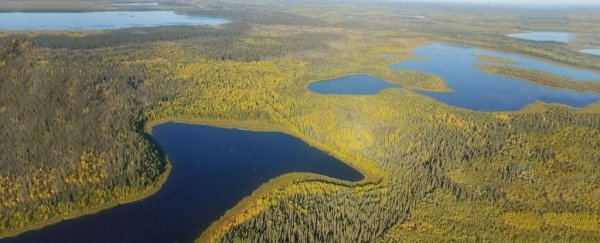By now, you've probably heard that the Arctic is not doing so well. It's warming faster than the rest of the world, blue lakes are bubbling with methane gas, and Arctic soils could be releasing carbon that's been trapped there since ancient times.
But there's a sliver of good news – a new study suggests that a particular type of Arctic lake may not pose as much of a threat to global carbon levels as we thought. For now at least.
Much of the Arctic is covered in something called permafrost – a thick layer of ice that rarely (if ever) melts.
But as the world quickly heats up, we're losing that permafrost, which is exposing soil and vegetation that's been frozen for hundreds of thousands of years. The impact of this is serious, since that soil and vegetation is currently storing double the amount of carbon as what's currently in the atmosphere.
Once exposed, if soil microbes chew through the organic matter and release the carbon as carbon dioxide and methane, we'll be in even more of a pickle than we are now.
Previous research left scientists concerned, after discovering that some Arctic lakes, known as thermokarsts, can cause the permafrost around them to melt even faster, accelerating the release of deeply frozen carbon.
But there's room for cautious optimism thanks to the new study by the University of Washington and US Geological Survey, which shows that not all Arctic lakes are receiving carbon at the same speed as the dramatically thawing thermokarsts.
"We found that not all high-latitude lakes are big chimneys of carbon to the atmosphere, and that lakes in the region are not actively processing much permafrost or plant carbon from land," said bigeochemist Matthew Bogard from the University of Washington.
"Documenting the heterogeneous nature of northern lakes, as we have done here, will better define the role of Arctic lakes in the global carbon cycle."
The researchers went out and took multiple samples from at least 20 lakes in the Yukon Flats region of northeast Alaska during June and August 2016, and April 2017.
Yukon Flats are an arid landscape littered with flat lakes; as the researchers explain, it's a scenery that makes up a quarter of the northern circumpolar lake area, but has had limited research done on it.
But braving pretty intense conditions, the team measured a number of factors for each lake, including the dissolved inorganic carbon in the water, as well as the water temperature and the pH.
In nearly every lake they tested, there were no signs of ancient carbon that had been released from permafrost; therefore, the lakes were producing less carbon emissions then had been expected.
But we're not out of the woods yet.
"The implications are that not all lakes are hot spots for releasing carbon from land," explained environmental scientist David Butman from the University of Washington.
"But we don't yet know how these particular landscapes will change in a warmer climate, since this is the first time they've been studied."
Plus, even if this huge carbon source stays in the ground where it belongs, our climate is still warming at an unprecedented level - let's just hope our leaders start listening and taking action.
The research has been published in Nature Geoscience.
